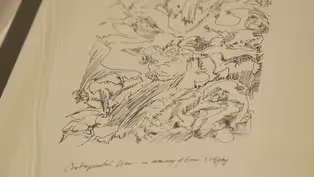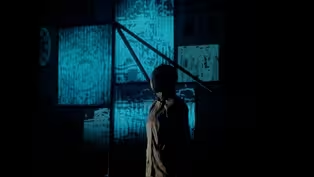State of the Arts
The Wild Baskets of Steven R. Carty
Clip: Season 42 Episode 3 | 7m 4sVideo has Closed Captions
Steven R. Carty is a second-generation basketmaker from the South Jersey Pinelands.
Steven R. Carty is a second-generation basketmaker from the South Jersey Pinelands. We go on location as he gathers materials for his freeform baskets in the wild, including the invasive wisteria vine. We also visit Carty teaching at the Peters Valley School of Craft in the Delaware Water Gap in rural Northeast New Jersey.
Problems playing video? | Closed Captioning Feedback
Problems playing video? | Closed Captioning Feedback
State of the Arts is a local public television program presented by NJ PBS
State of the Arts
The Wild Baskets of Steven R. Carty
Clip: Season 42 Episode 3 | 7m 4sVideo has Closed Captions
Steven R. Carty is a second-generation basketmaker from the South Jersey Pinelands. We go on location as he gathers materials for his freeform baskets in the wild, including the invasive wisteria vine. We also visit Carty teaching at the Peters Valley School of Craft in the Delaware Water Gap in rural Northeast New Jersey.
Problems playing video? | Closed Captioning Feedback
How to Watch State of the Arts
State of the Arts is available to stream on pbs.org and the free PBS App, available on iPhone, Apple TV, Android TV, Android smartphones, Amazon Fire TV, Amazon Fire Tablet, Roku, Samsung Smart TV, and Vizio.
Providing Support for PBS.org
Learn Moreabout PBS online sponsorshipCarty: To me, they're kind of their own silent neighborhood.
People who weren't neighbors in life are now neighbors in death.
My mother's father's family were all Pineys.
His family was back colonial times in New Jersey, I believe the first Bozarth to move up here in 1713.
Evesham.
They called it Evesham Township.
It was all Evesham at one time.
Now it's Mount Laurel.
I come over here at least twice a week, at least once a week, and my house is just over that way.
In fact, I see the top of my house from here.
[ Chiming ] My mother's a basket weaver, so I grew up with it and I learned from her.
But then I started teaching myself wild materials, so I got into that.
Well, these materials are all wild-gathered by me, and there's an advantage to that, gathering stuff from the wild, is that it's complete quality control.
I control it.
So, something like cedar bark here -- I have to kill the tree to do it, but I go where the trees are overgrown, and I can't just take any cedar tree.
I need one the right, like, thickness of the tree, the right length up, that's branch-free, so usually trees that are overgrown and, you know, crowd out by each other.
So it's a good way of keeping the forest healthy.
And you'll often find red cedars growing like weeds in places like abandoned houses and stuff like that, abandoned fields.
See how this one's the smooth side out?
That's the inside of the bark.
And just for aesthetics, I wanted to go with this smoother look here, where this one, I'm doing it a little different, because I like to do them all a little different.
And I get the shaggy end of the bark out and the smooth end in.
It's just about how you want it to look.
The wisteria, though, the vine part is an invasive.
So that's an invasive vine around here.
It grows, like, insane.
I'll clear out a little place, and a year or two later, I got to go back up and pull the same runners.
But what I harvest isn't so much the vines of wisteria.
I'm out there harvesting the runners.
I have situations at times in the woods where private property is a no-go because somebody owns the property and I just can't go in there and harvest wild materials.
Public lands, certain places like state forests, county parks, I can have some misunderstandings with, you know, authorities when I'm removing an invasive plant, which I'm doing the environment a favor.
So, a place like here, though, I have permission to come out here and clear the trail of wisteria.
We're in a section of Whitesbog here.
This part in here is a little holly forest in here.
Holly does occur in the Pine Barrens.
You find little spots of it.
Wisteria is taking over in here, and this will kill these trees.
That's a vine here, and here is a runner.
A very large runner.
The runners I use are more this size.
That's how they start out.
And they colonize from one place to another.
And these are what I pull out to remove, before they get to this big.
So this helps Whitesbog with this trail.
I'm really grateful and thankful to them for letting me come out here and, you know, remove wisteria, which helps them so nobody trips on the trail and it doesn't take over the little forest here and gets me basketry material.
Mueller: Every culture has a form of basketry.
In fact, probably was developed by observing how birds make nests, right?
People learn how to make containers out of fiber.
He's so creative in the way he uses traditional basketry techniques to make contemporary basket forms.
So they're kind of small sculptures.
He's very contemplative, and that, I think, attracts people.
Steven has been teaching for us for over a decade.
He's providing all of the materials for the students and having them learn about the materials and how to harvest them, but then helping them seek out their vision and their forms and shapes.
So sometimes, it might be responding to the pieces of bark that you have.
Reid: This is the wisteria bark.
I have this big needle, and I'm taking pieces of the wisteria, like, thin pieces, as the "thread," and I'm using it and threading it through the needle and going into this cording that I made with the wisteria by twisting it around.
Press: I've got an appreciation for using only natural materials together and not mixing them with manmade things and not using power tools.
Chorun: I always knew about, like, the rattan baskets, but I had no idea how to go about it naturally, so that's been really cool.
Like, a lot of my own work.
I do foraging, too, so -- but a very different way.
So, Steven's been, like, so kind as to offer us to take things home, so I definitely want to do that and try to continue practicing.
Mechanic: We're here in the Delaware Water Gap National Recreation Area, so we cannot use materials within park.
So, Steven was able to forage and bring all of his own materials here to the valley.
Carty: One thing that really comes up with the basketry -- I've been more and more vocal about it -- is land use, land-use rights.
Whether I'm on public land or private land, there's always somebody saying, "Don't harvest this" or "Don't take this."
And they can't tell me the life cycle of this plant.
They can't tell me anything about it.
That always comes into this.
I'm always conscious of that going on.
So, most of your South Jersey baskets were white oak.
You get up to North Jersey, brown ash was more prevalent because brown ash trees, at one time, grew that far south.
So, what I'm doing you wouldn't have seen as much traditionally in the Pine Barrens.
People wouldn't have been pulling up wisteria.
They wouldn't have been using, like, cedar bark.
But it's just my way of, hey, I know the materials, I know the wild.
You know, I can figure something out.
Like, "Oh, this bark would work for weaving" or "This vine would work good for weaving."
So what I do is a little traditional, a little modern.
It's traditional in that I just go out, I gather my own materials, I'm making a basket.
It's also contemporary in that I'm finding new ways and using new materials.
I'm using materials that are already here that somebody else didn't think of.
So I'm always trying to rethink something, relook at something, and do my own spin on it.
Judith K. Brodsky: A Force in the Arts
Video has Closed Captions
Clip: S42 Ep3 | 9m 56s | We meet artist, scholar, print maker and feminist pioneer, Judith Brodsky. (9m 56s)
Video has Closed Captions
Clip: S42 Ep3 | 6m 30s | West Orange's Luna Stage puts on Westphalia, an new play about citizenship and AI. (6m 30s)
Providing Support for PBS.org
Learn Moreabout PBS online sponsorshipSupport for PBS provided by:
State of the Arts is a local public television program presented by NJ PBS













